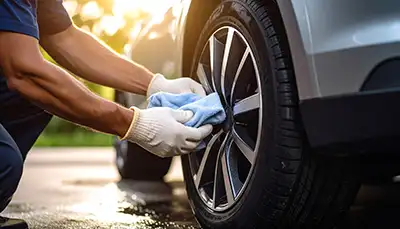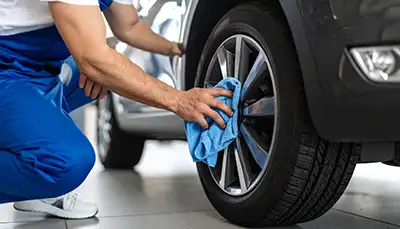Essential Maintenance for Wheels & Tires
Proper maintenance of your custom wheels and tires isn't just about aesthetics—it's about safety, performance, and protecting your investment. With the right care routine, you can significantly extend the life of both your wheels and tires while ensuring optimal vehicle performance.
Tire Pressure Maintenance
Maintaining correct tire pressure is perhaps the single most important aspect of tire care. Proper inflation ensures even tread wear, optimal fuel efficiency, and safer handling.
- Check pressure monthly: Use a quality tire pressure gauge to check all tires, including your spare, at least once a month.
- Check when cold: Measure pressure when tires are cold (vehicle hasn't been driven for at least three hours) for the most accurate reading.
- Follow manufacturer specifications: The recommended PSI for your vehicle can be found on the driver's side door jamb sticker or in your owner's manual.
- Seasonal adjustments: Remember that tire pressure can drop approximately 1 PSI for every 10°F decrease in temperature.
Tire Rotation Schedule
Regular tire rotation promotes even tread wear, extending tire life and maintaining consistent handling and traction.
- Every 5,000-7,000 miles: Most vehicles benefit from rotation at this interval, though always check your vehicle's specific recommendations.
- Rotation patterns: The correct pattern depends on whether you have directional or non-directional tires, and whether your vehicle is front, rear, or all-wheel drive.
- Combine with other services: Many drivers rotate tires during oil changes for convenience.
Wheel Cleaning & Protection
Proper cleaning not only keeps your wheels looking their best but also prevents damage from brake dust and road contaminants.
- Weekly cleaning: Rinse wheels thoroughly with water before applying any cleaners.
- Use appropriate cleaners: Choose wheel cleaners specifically formulated for your wheel's finish (chrome, painted, polished aluminum, etc.).
- Avoid harsh chemicals: Never use household cleaners or acid-based products that can damage wheel finishes.
- Apply wheel sealant: After cleaning, apply a quality wheel sealant or wax every 3 months to protect against brake dust, road salt, and other contaminants.
- Dedicated brushes: Use soft-bristled brushes designed for wheels to prevent scratching delicate finishes.

Wheel Alignment & Balancing
Proper alignment and balancing are crucial for even tire wear and optimal handling performance.
- Alignment check annually: Have your alignment checked at least once per year or after hitting significant potholes or curbs.
- Watch for symptoms: Uneven tire wear, vehicle pulling to one side, or steering wheel vibration are signs of alignment or balancing issues.
- Rebalance after tire repair: Any time a tire is removed for repair, it should be rebalanced before reinstallation.
Seasonal Maintenance
Different seasons present unique challenges for wheel and tire care.
Winter Care
- Remove road salt promptly: Salt and winter chemicals can corrode wheel finishes if left untreated.
- Consider winter tires: If you live in areas with regular snowfall or freezing temperatures, dedicated winter tires provide superior traction and safety.
- Check pressure more frequently: Cold temperatures cause significant pressure drops that can affect handling.
Summer Care
- Check for UV damage: Extreme heat can accelerate tire aging. Look for cracks or discoloration.
- Avoid overinflation: Hot pavement causes tire pressure to increase, so don't inflate beyond recommended levels during summer.
Inspecting Tires for Wear & Damage
Regular visual inspections can catch potential issues before they become safety hazards.
- Check tread depth: Use the penny test (insert a penny with Lincoln's head upside down; if you can see all of his head, the tread is too worn) or a proper tread depth gauge.
- Look for irregular wear: Scalloping, feathering, or one-sided wear often indicate alignment or suspension issues.
- Check for punctures: Examine tires for nails, screws, or other embedded objects that could cause slow leaks.
- Inspect sidewalls: Look for cuts, cracks, bulges, or other damage that could lead to blowouts.

Key Takeaways: Wheel & Tire Maintenance
- Check tire pressure monthly and before long trips for safety and fuel efficiency.
- Rotate tires every 5,000-7,000 miles to ensure even wear and extend tire life.
- Clean wheels regularly with appropriate products for your specific wheel finish.
- Maintain proper alignment and balancing to prevent uneven wear and handling issues.
- Inspect tires regularly for wear indicators, damage, and proper tread depth.
- Apply wheel sealants quarterly to protect against environmental damage.
- Adjust maintenance routines seasonally for optimal performance year-round.
FAQ: Wheel & Tire Maintenance
How often should I check my tire pressure?
You should check your tire pressure at least once a month and before any long trips. Always check when tires are cold (vehicle hasn't been driven for at least three hours) for the most accurate reading.
What's the best way to clean custom wheels without damaging them?
Start by rinsing thoroughly with water to remove loose debris. Use a cleaner specifically formulated for your wheel's finish (chrome, painted, polished aluminum, etc.). Apply with a soft-bristled brush or microfiber cloth, then rinse thoroughly. Avoid harsh chemicals and never clean wheels when they're hot.
How do I know when my tires need to be replaced?
The standard recommendation is to replace tires when tread depth reaches 2/32 of an inch. You can use the penny test (insert a penny with Lincoln's head upside down; if you can see all of his head, the tread is too worn) or a tread depth gauge. Also replace tires showing sidewall damage, bulges, or that are more than 6 years old regardless of tread depth.
Is it worth applying wheel sealants or protectants?
Absolutely. Quality wheel sealants create a protective barrier against brake dust, road salt, and environmental contaminants. This not only keeps wheels looking better but also makes future cleaning easier and prevents premature finish deterioration. For best results, apply every 3 months after a thorough cleaning.
How often should I rotate my tires with custom wheels?
The standard recommendation is every 5,000-7,000 miles, though you should always check your vehicle's specific maintenance schedule. If your vehicle has different size tires front and rear (staggered setup), traditional rotation isn't possible, but side-to-side rotation may still be beneficial.
Can I use automatic car washes with custom wheels?
We generally recommend avoiding automatic car washes with brushes, as they can potentially scratch or damage custom wheel finishes. Touchless automatic car washes are safer, but hand washing remains the best option for preserving your wheel's appearance and finish longevity. Find more Wheel and Tire Tech information.